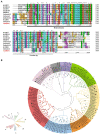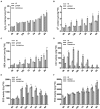CRISPR/Cas9 mediated gene-editing of GmHdz4 transcription factor enhances drought tolerance in soybean (Glycine max [L.] Merr.)
- PMID: 36061810
- PMCID: PMC9437544
- DOI: 10.3389/fpls.2022.988505
CRISPR/Cas9 mediated gene-editing of GmHdz4 transcription factor enhances drought tolerance in soybean (Glycine max [L.] Merr.)
Abstract
The HD-Zip transcription factors play a crucial role in plant development, secondary metabolism, and abiotic stress responses, but little is known about HD-Zip I genes in soybean. Here, a homeodomain-leucine zipper gene designated GmHdz4 was isolated. Chimeric soybean plants, GmHdz4 overexpressing (GmHdz4-oe), and gene-editing via CRISPR/Cas9 (gmhdz4) in hairy roots, were generated to examine the GmHdz4 gene response to polyethylene glycol (PEG)-simulated drought stress. Bioinformatic analysis showed GmHdz4 belonged to clade δ, and was closely related to other drought tolerance-related HD-Zip I family genes such as AtHB12, Oshox12, and Gshdz4. The GmHdz4 was located in the plant nucleus and showed transcriptional activation activity by yeast hybrid assay. Quantitative real-time PCR analysis revealed that GmHdz4 expression varied in tissues and was induced by PEG-simulated drought stress. The gmhdz4 showed promoted growth of aboveground parts, and its root system architecture, including the total root length, the root superficial area, and the number of root tips were significantly higher than those of GmHdz4-oe even the non-transgenic line (NT) on root tips number. The better maintenance of turgor pressure by osmolyte accumulation, and the higher activity of antioxidant enzymes to scavenge reactive oxygen species, ultimately suppressed the accumulation of hydrogen peroxide (H2O2), superoxide anion (O2-), and malondialdehyde (MDA), conferring higher drought tolerance in gmhdz4 compared with both GmHdz4-oe and NT. Together, our results provide new insights for future research on the mechanisms by which GmHdz4 gene-editing via CRISPR/Cas9 system could promote drought stress and provide a potential target for molecular breeding in soybean.
Keywords: Glycine max; GmHdz4; HD-ZIP; drought stress; root system architecture.
Copyright © 2022 Zhong, Hong, Shu, Li, Liu, Chen, Islam, Zhou and Tang.
Conflict of interest statement
The authors declare that the research was conducted in the absence of any commercial or financial relationships that could be construed as a potential conflict of interest.
Figures








Similar articles
-
A novel Glycine soja homeodomain-leucine zipper (HD-Zip) I gene, Gshdz4, positively regulates bicarbonate tolerance and responds to osmotic stress in Arabidopsis.BMC Plant Biol. 2016 Aug 24;16(1):184. doi: 10.1186/s12870-016-0872-7. BMC Plant Biol. 2016. PMID: 27553065 Free PMC article.
-
Functional Characterization of the Soybean Glycine max Actin Depolymerization Factor GmADF13 for Plant Resistance to Drought Stress.Plants (Basel). 2024 Jun 14;13(12):1651. doi: 10.3390/plants13121651. Plants (Basel). 2024. PMID: 38931083 Free PMC article.
-
Drought Tolerance Conferred in Soybean (Glycine max. L) by GmMYB84, a Novel R2R3-MYB Transcription Factor.Plant Cell Physiol. 2017 Oct 1;58(10):1764-1776. doi: 10.1093/pcp/pcx111. Plant Cell Physiol. 2017. PMID: 29016915
-
Identification and characterization of GmMYB118 responses to drought and salt stress.BMC Plant Biol. 2018 Dec 3;18(1):320. doi: 10.1186/s12870-018-1551-7. BMC Plant Biol. 2018. PMID: 30509166 Free PMC article.
-
A moso bamboo transcription factor, Phehdz1, positively regulates the drought stress response of transgenic rice.Plant Cell Rep. 2021 Jan;40(1):187-204. doi: 10.1007/s00299-020-02625-w. Epub 2020 Oct 24. Plant Cell Rep. 2021. PMID: 33098450
Cited by
-
Advances in Soybean Genetic Improvement.Plants (Basel). 2024 Oct 31;13(21):3073. doi: 10.3390/plants13213073. Plants (Basel). 2024. PMID: 39519991 Free PMC article. Review.
-
Advances in CRISPR/Cas9-based research related to soybean [Glycine max (Linn.) Merr] molecular breeding.Front Plant Sci. 2023 Aug 30;14:1247707. doi: 10.3389/fpls.2023.1247707. eCollection 2023. Front Plant Sci. 2023. PMID: 37711287 Free PMC article. Review.
-
The Potential of CRISPR/Cas Technology to Enhance Crop Performance on Adverse Soil Conditions.Plants (Basel). 2023 May 5;12(9):1892. doi: 10.3390/plants12091892. Plants (Basel). 2023. PMID: 37176948 Free PMC article. Review.
-
Modification of Fatty Acid Profile and Oil Contents Using Gene Editing in Oilseed Crops for a Changing Climate.GM Crops Food. 2023 Dec 31;14(1):1-12. doi: 10.1080/21645698.2023.2243041. Epub 2023 Aug 8. GM Crops Food. 2023. PMID: 37551783 Free PMC article. Review.
-
Exploring physiological and molecular dynamics of drought stress responses in plants: challenges and future directions.Front Plant Sci. 2025 Mar 24;16:1565635. doi: 10.3389/fpls.2025.1565635. eCollection 2025. Front Plant Sci. 2025. PMID: 40196426 Free PMC article. Review.
References
-
- Alexieva V., Sergiev I., Mapelli S., Karanov E. (2001). The effect of drought and ultraviolet radiation on growth and stress markers in pea and wheat. Plant Cell Envi. 24, 1337–1344. doi: 10.1046/j.1365-3040.2001.00778.x - DOI
LinkOut - more resources
Full Text Sources
Other Literature Sources
Research Materials

